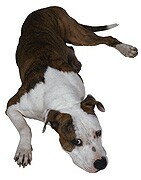
MONDAY, Oct. 11 (HealthDay News) — If you want to leave your dog home alone without having to worry about chewed furniture or never-ending barking, you’d better hope your dog knows how to look at the sunny side of life.
Dogs that showed pessimistic-like behaviors in a recent study were more likely to become distressed and anxious when left alone and to show they were upset by barking, jumping on furniture, scratching at the door and repetitive behaviors. Optimistic dogs, on the other hand, were more relaxed and better behaved when on their own.
The study is published in the Oct. 12 issue of Current Biology.
To test dogs’ propensity for separation anxiety-related behaviors, researchers played with each of 24 dogs recently sent to shelters in a room for 20 minutes. The next day, they took each dog back to the room, then left the animal alone.
For the next five minutes, researchers videotaped the dog’s behavior, looking for signs of anxiety such as barking, jumping on furniture or scratching at the door.
Researchers then taught the dogs to expect that when a bowl was placed at a specific location in a room, the bowl would be full of food. When the bowl was placed in another location, it would be empty.
Afterward, researchers moved the bowl around the room, each time putting it in an ambiguous location where a dog couldn’t know for sure if it would contain food or not.
Dogs that ran quickly to the ambiguous bowl were considered “optimistic.” Those that ran slowly toward the food were considered “pessimistic.”
The videotapes showed pessimistic pooches were more likely to exhibit separation-related behaviors when left alone, while dogs that saw life as a glass “half full” were less likely to become anxious when left alone.
In people, and perhaps in dogs, internal emotional states can impact behavior and decision-making, said study author Michael Mendl, a research fellow in the department of clinical veterinary science at University of Bristol.
Just as depressed people are more likely to think the worst or to judge ambiguous situations negatively while happy people tend to look on the bright side of life, dogs may have similar tendencies.
“Dogs showing signs of separation-related behavior were also likely to make ‘pessimistic’ judgments about ambiguous stimuli,” Mendl said. “Because pessimistic judgments may be related to an underlying negative emotional state, this gives us an insight into the emotional state of dogs showing separation-related behaviors.”
Researchers controlled for breed, sex and age of the dog, olfactory cues and how quickly they learned which bowl contained the food and which didn’t, according to the study.
In training dogs, Katenna Jones, an animal behaviorist and humane educator for the American Humane Association, said she has often noticed that dogs that have separation anxiety also show other signs of high-strung or neurotic behavior, such as being easy to startle, overreacting to touch or being excessively protective of toys or food bowls.
Yet Jones said using words such as “optimistic” and “pessimistic” runs the risk of anthropomorphizing dogs, or assigning them human-like behaviors and thought processes.
“I’m no fan of the terms ‘optimistic’ and ‘pessimistic.’ Instead of optimistic, maybe words like inquisitive, exploratory or energetic would be better,” Jones said. “I find dogs that have more confidence, [that are] less anxious and well-socialized tend to be more eager and driven to learn.”
It’s still fun to think about what’s going through your pet’s head.
“Is your dog an Eeyore or a Tigger?” Jones said. “Maybe an Eeyore dog is thinking, ‘Oh, there’s no sense trying. The bowl is going to be empty.’ A pessimistic or depressed person might say, ‘There’s no sense going to work. It’s going to be another bad day’.”
If your dog is urinating in the house or destroying household items when left alone, Jones and Mendl urged pet owners to seek help from a professional such as a veterinary behaviorist. Dogs can be taught to cope better with being left alone.
Keep in mind, Jones said, that many dogs exhibiting such behaviors may not be anxious, but just not getting enough exercise or bored.
Added Mendl: “Dogs are very popular pets in the U.S.A. and Europe. Not only are there a lot of them, but they live very closely with people and are dependent on us for their care and welfare. It’s also important to understand them to reduce public health risks associated with dog behavior.”
More information
For more on dogs, visit the American Humane Association.

